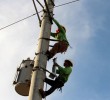“It’s very ironic that Kidapawan City and the rest of the province continue to suffer from rotational brown-outs when we host two Mt. Apo geothermal plants that have the combined capacity of 104 MW,” said Ruby Padilla-Sison of the Makabayan Peoples Coalition.
By DANILDA L. FUSILERO
Davao Today
KIDAPAWAN CITY, Cotabato, Philippines — Militant groups continue to criticize government’s apparent palliative solution to the perennial power shortage problem in many areas of Mindanao.
Members of the militant Kabataan Party-list staged a two-day Paaralang Bayan (public issue discussion) in major streets here, lambasting the Aquino administration for its failure to “genuinely solve” the electrical power problem which has resulted in daily 45-minute rotational brown-outs in the province despite the preventive maintenance shutdown of two power plants, which restored 210 megawatts (MW) to the Mindanao electrical power grid.
The Steag coal power plant in Misamis Oriental completed its maintenance shutdown last November 10. However, Steag capacity is just 20 percent of the entire island’s current power capacity.
Mindanao’s peak hour power demand is pegged at 1,300 MW. As of the first quarter of this year, the Mindanao grid declared a total installed capacity of 1,521.08 MW with a dependable capacity of 1,261.66 MW.
Installed capacity is the number of megawatts a power plant can produce while dependable capacity is the plant’s capacity to produce during the peak hours.
The National Grid Corporation of the Philippines (NGCP) announced this week that Mindanao is still under a “red status” due to an absence of reserve power to meet the island’s demand. The situation has forced the local Cotabato Electric Cooperative to continue its daily rotational brown-out schedule.
Abdulrahman Malabana of the Kabataan Partylist told Davao Today that the problem is affecting households, academic institutions, industries and the business sectors. Malabana accused the government of “relinquishing its mandate to protect the welfare of the people from the hands of the private sector through the implementation of the Electric Power Reform Act.”
“It’s very ironic that Kidapawan City and the rest of the province continue to suffer from rotational brown-outs when we host two Mt. Apo geothermal plants that have the combined capacity of 104 MW,” said Ruby Padilla-Sison of the Makabayan Peoples Coalition.
Sison also expressed doubt over the government’s sincerity in rehabilitating hydro-electric plants that have not performed well because of siltation. “How could government arrest (the) siltation (problem) if it continuously promotes mining and cash crop plantations, which both induce top soil erosions cause and siltation?,” Sison questioned.
Makabayan Coalition is, likewise, demanding that government put a halt on its privatization efforts of the remaining electric power facilities rather than opting to construct more power generation plants.
Rev. Felixberto Rodenas of the Bayan Muna party-list also said that the government’s privatization program of the power industry leaves the people helpless. “Leaving the power generation, transmission and even distribution in the hands of the big businessmen like the Lopezes, Aboitizes and Conjuangcos is stupid, foolish,” Rodenas said.
Makabayan urged the passage of House Bill 5405 of Senatorial candidate Teddy Casiño which will re-direct government’s investment into solar power generation. HB 5405 or the One Million Solar Roofs Act promotes solar energy as an immediate and sustainable way to deal with the country’s energy problem.
The continued shortage of power supply in Mindanao is attributed to the limited generation capacity of the Agus-Pulangi hydropower complex. The oldest hydro power plant Agus 6 was commissioned in 1953 while Agus 4 and 5 were both commissioned in the ‘80s are now manifesting decrease in its power generation capacity. For instance, Agus 4’s dependable capacity of 145 MW dropped to 143.67 MW; Agus 5’s 53 MW to 52 MW; and Agus 6’s 140.67 MW to 134.67 MW.
NGCP earlier projected that power outages will worsen as new businesses and factories open in major cities of Mindanao like Davao City during the last quarter of the year in time for the holidays. In Kidapawan City, a branch of the Gaisano Mall chain of department stores is expected to operate before the year ends.
Steag GmbH is a German owned company and is the fifth biggest electricity producer in Germany. According to its website, it has been in the business of power generation for more than 70 years and generated sales of EUR 2.8 billion and an EBITDA of EUR 437 million in 2010. (Danilda L. Fusilero/davaotoday.com)










